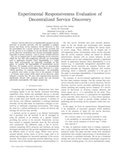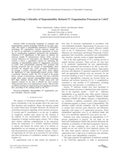A Model for Evaluation of User-Perceived Service Properties
Sunday, March 10, 2013, 13:46 |
Authors: Andreas Dittrich Igor Kaitovic Cristina Murillo Rafael Rezende 27th IEEE International Symposium on Parallel Distributed Processing, Workshops and PhD Forum, IPDPSW 2013, Boston, MA, USA, May 20-24, 2013 Download: accepted version, final published version |
An ever-increasing number of both functional and non-functional requirements has resulted in growing system complexity which demands new solutions in system modeling and evaluation. As a remedy, service-oriented architecture (SOA) offers services as basic building elements of system design. Service dependability is highly dependent on the properties of the underlying information and communications technology (ICT) infrastructure. This is especially true for the user-perceived dependability of a specific pair service client and provider as every pair may utilize different ICT components. We provide a model for the description of ICT components and their non-functional properties based on the Unified Modeling Language (UML). Given a service description, a network topology model and a pair service client and provider, we propose a methodology to automatically identify relevant ICT components and generate a user-perceived service infrastructure model (UPSIM). We demonstrate the feasibility of the methodology by applying it to parts of the service network infrastructure at University of Lugano (USI), Switzerland. We then show how this methodology can be used to facilitate user-perceived service dependability analysis.
Categories: Publication, Research and Education
Tags: Availability, Client-server systems, Dependability, Design engineering, Distributed computing, Fault tolerance, Metamodeling, Modeling, Network, Object oriented modeling, Quality of service, Service dependability, Service network management, Service networks, SOA, UML


